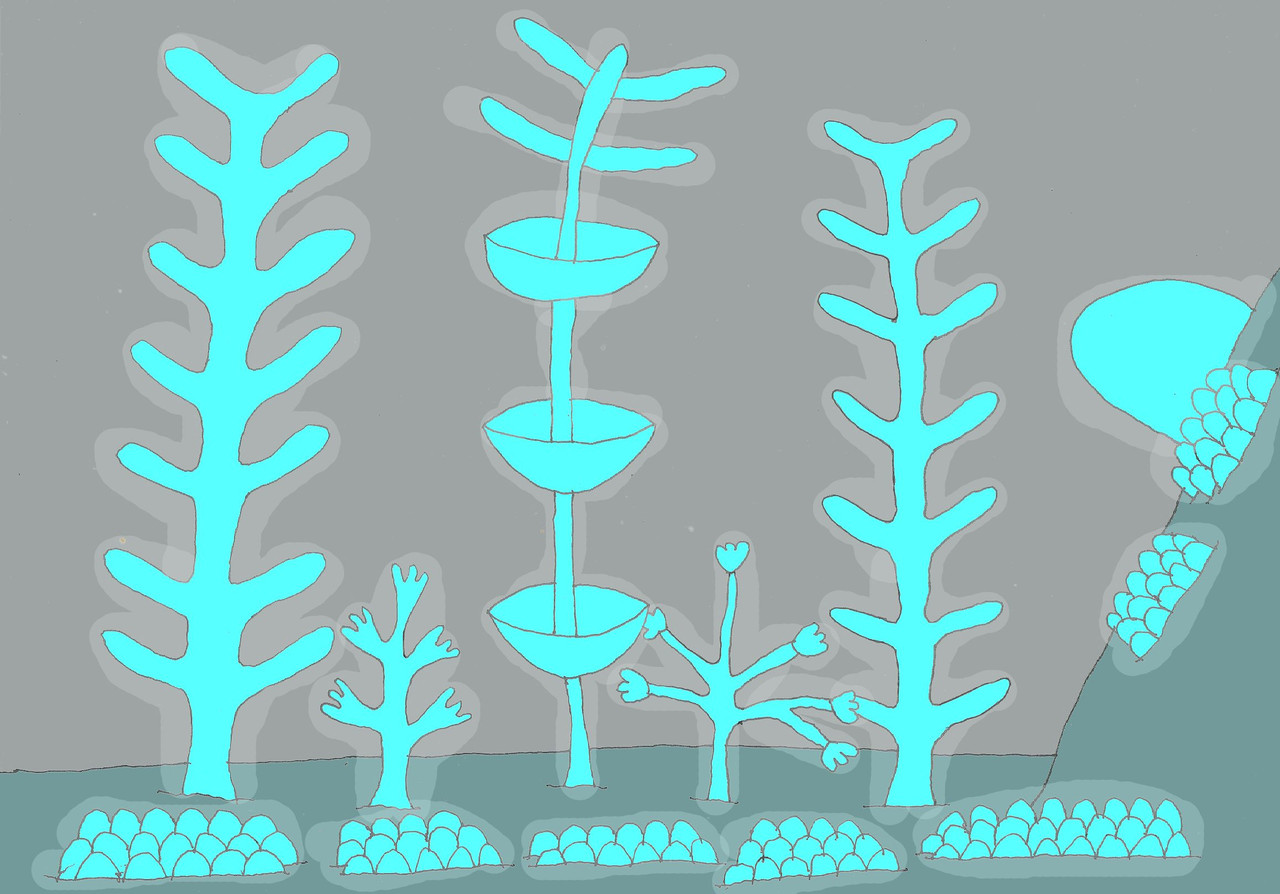HOME | DD
 Tarturus — Cave polyp sacs
Tarturus — Cave polyp sacs

#cerulea #polyp #sac #tarturus #alienplanet #alienworld #bioluminescence #cave #sciencefiction #scifi #xenobiology #speculativeevolution #speculativebiology
Published: 2020-07-14 03:35:16 +0000 UTC; Views: 823; Favourites: 6; Downloads: 0
Redirect to original
Description
Cerulea's cave networks have more polyp sacs than any other habitat on Cerulea. This is probably due to the greatly reduced need to compete with plants for space to lay down roots. Like Earth plants, Cerulean plants are all photosynthetic. As such they are absent from much of the sunless environs of the caves, growing only in spots where sunlight streams in from cave entrances or holes in the cave ceiling. Polyp sacs, however, are heterotrophic and therefore are quite capable of living in sunless places as long as they get enough food.The ground in the caves is often covered in a layer of soil and while the cave soil tends to be dry and hard it still possesses communities of tiny soil organisms, including the super numerous thread worms. The predator roots of the cave dwelling polyp sacs regularly catch such organisms for food. This alone does not add up to all that much sustenance, but there are other sources as well. Like the spores of their neighbours.
While living in large numbers and in close proximity can lead to competition it also leads to more food. As the various polyp sacs release their spores only some will manage to take root and become new polyp sacs. Many others will be devoured by those polyp sacs adapted to filter feeding air-borne spores. Because spores tend to travel shorter distances in caves than outside (except in parts where wind can blow in from outside), filter feeders actually benefit from being close to others, even if potential competitors. As well as the spores of other polyp sacs, the spores of the odd spore creatures are also food. The filter feeder polyp sacs are not picky.
The presence of so many polyp sacs in the caves has formed the basis for an ecosystem that can support various animals that feed on the polyp sacs, especially pseudo-arthropods and shield heads, as well as predatory animals that feed on the polyp eaters, especially pseudo-arthropods and radials. In turn, this also allows for the presence of polyp sacs who are not filter feeders but rather consumers of things like small pseudo-arthropods and decomposing organic matter. Any small pseudo-arthropod going to feed on the polyps of a polyp sac runs the risk that the polyp may well end up eating the polyp eater.
The polyp sacs of the caves have a great diversity of forms. The smallest are the ground polyps, which are the most basal group of the terrestrial polyp sacs. They appear as just small round or oval sacs sticking out of the ground and seem to feed exclusively on microbes and on tiny animals such as thread worms. Despite the name "ground polyps", these organisms can also be found growing on cave walls and even on cave ceilings. As long as the rock is porous enough they can set root and feed on the films of microbes that live on and in the rock.
There are various shrub-like cave polyps not too similar to the shrub-like polyp sacs one can find in non-cave environments such as the open plains. The most common polyp sacs on the plains are the trilobe polyp sacs (who use predator polyps) and the land anemones (who are filter feeders). In the caves these groups are also present as well a number of groups of shrub-like forms not found anywhere outside the caves.
Arguably the most impressive are the tree-sized forms. These are found only in cave environments. While polyp sacs in non-cave environments seldom grow much taller than 1 metre, tree-like cave polyp sacs can grow up to as tall as 9 metres. They make for rather odd-looking (to our point of view) trees, often with strange branching sacks in place of actual branches and nothing resembling leaves. One group of tree-like polyp sacs has had polyps evolve into strange dish-like structures that wrap around the trunk, but with more "standard" polyps up towards the top.
One rather interesting aspect of the cave dwelling polyp sacs is that they are all bioluminescent. They form symbiotic relationships with microbes that produce luciferin throughout their "skin" causing them to glow. The reason for the evolution of this bioluminescence remains unclear. Furthermore, as the cave polyp sacs are not a monophyletic group but come from all the major clades of terrestrial polyp sacs, the bioluminescence must have evolved independently on more than just one occasion. It is noteworthy that a lot of the cave dwelling animals are also bioluminescent. Whatever the reason, all this has resulted in caves that are surprisingly well lit. Despite the lack of sunlight, areas of pitch black are not all that common, with much of the caves lit up by an ethereal glow that comes mostly from the numerous polyp sacs.
























